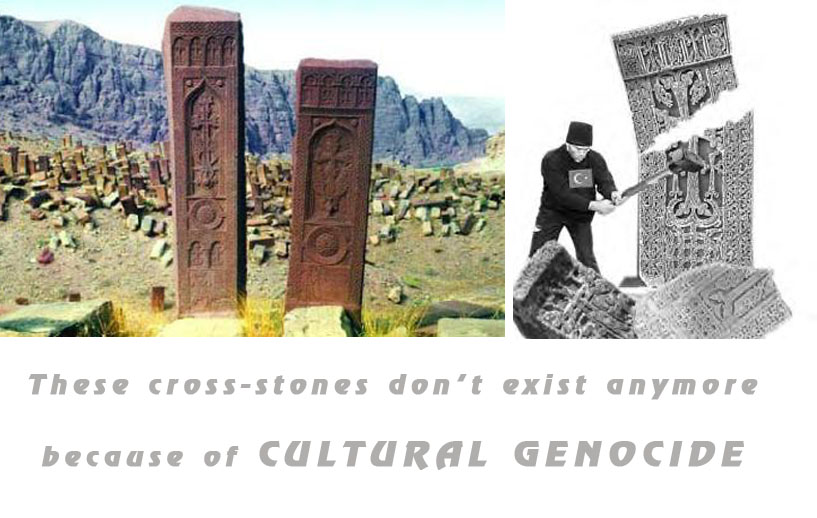Now you can find materials on popular web site
http://globalheritagefund.org/ (Global Heritage Network),
which represents Cultural Genocide in Jugha
Here you will read about cultural genocide in general and about cultural genocide in Jugha cemetery in particular. Jugha cemetery was an armenian medieval cemetery with lots of khachkars (cross-stones).But Azerbaijan soldiers destroyed the cemetery in 2005 december. And that was an act of vandalism, that was/IS a cultural genocide
This cross-stones doesn't exist anymore, because of CULTURAL GENOCIDE

Sunday, November 21, 2010
The Jugha cemetery was a unique collection of several thousand carved stone crosses (khachkars) on Azerbaijan’s southern border with Iran. But...
Between 10-16 December 2005 over a hundred uniformed men destroyed the Djulfa cemetery using sledgehammers, cranes, and trucks.
An armenian medieval cemetery regarded as one of the wonders of the Caucasus has been
erased from the Earth in an act of cultural vandalism likened to the Taleban blowing up the
Bamiyan Buddhas in Afghanistan in 2001.
Between 10-16 December 2005 over a hundred uniformed men destroyed the Djulfa cemetery using sledgehammers, cranes, and trucks.
An armenian medieval cemetery regarded as one of the wonders of the Caucasus has been
erased from the Earth in an act of cultural vandalism likened to the Taleban blowing up the
Bamiyan Buddhas in Afghanistan in 2001.
 |
| Destruction of the statue by Taliban One of the two Buddahs of Bamiyan in 1976 After it was destroyed |
 |
| Armenian medieval khachkars. Jugha cemetry December 2005. Destroying of Armenian khachkars by azeri soldiers |
Jugha's cross-stones and Buddha's statue don't exist anymore because of CULTURAL GENOCIDE
Thursday, November 18, 2010
Wednesday, November 17, 2010
Intangible Cultural Heritage committee completes examination of nominations for UNESCO Lists
With the inscription of the Armenian cross-stones art. Symbolism and craftsmanship of Khachkars, presented by Armenia, the Intergovernmental Committee for the Safeguarding of the Intangible Cultural Heritage today finished the examination of 47 nominations presented by 29 countries for inscription on the Representative List of the Intangible Cultural Heritage of Humanity. It now includes 213 inscribed elements.
Khachkars are outdoor steles carved from stone by craftspeople in Armenia and communities in the Armenian diaspora. They act as a focal point for worship, as memorial stones and as relics facilitating communication between the secular and divine. Khachkars reach 1.5 metres in height, and have an ornamentally carved cross in the middle, resting on the symbol of a sun or wheel of eternity, accompanied by vegetative-geometric motifs, carvings of saints and animals. Khachkars are created usually using local stone and carved using chisel, die, sharp pens and hammers. The carvings are then ground using fine sand. Small breaks and rough surfaces are eliminated by plaster of clay or lime, and then painted. Once finished, the Khachkar is erected during a small religious ceremony. After being blessed and anointed, the Khachkar is believed to possess holy powers and can provide help, protection, victory, long life, remembrance and mediation towards salvation of the soul. Among more than 50,000 Khachkars in Armenia, each has its own pattern, and no two are alike. Khachkar craftsmanship is transmitted through families or from master to apprentice, teaching the traditional methods and patterns, while encouraging regional distinctiveness and individual improvisation.
As for the List of Intangible Cultural Heritage in Need of Urgent Safeguarding, four new elements have been added for a total of 16.
Monday, November 1, 2010
Subscribe to:
Posts (Atom)

